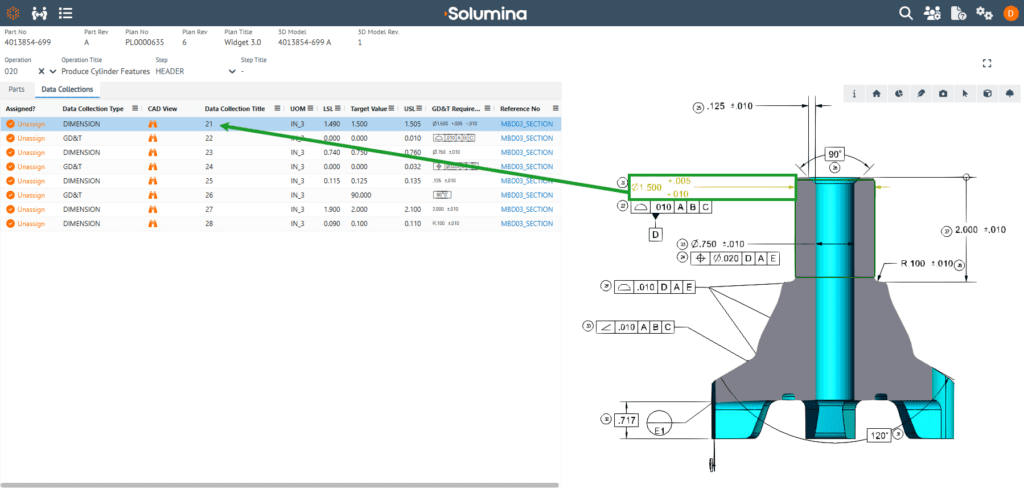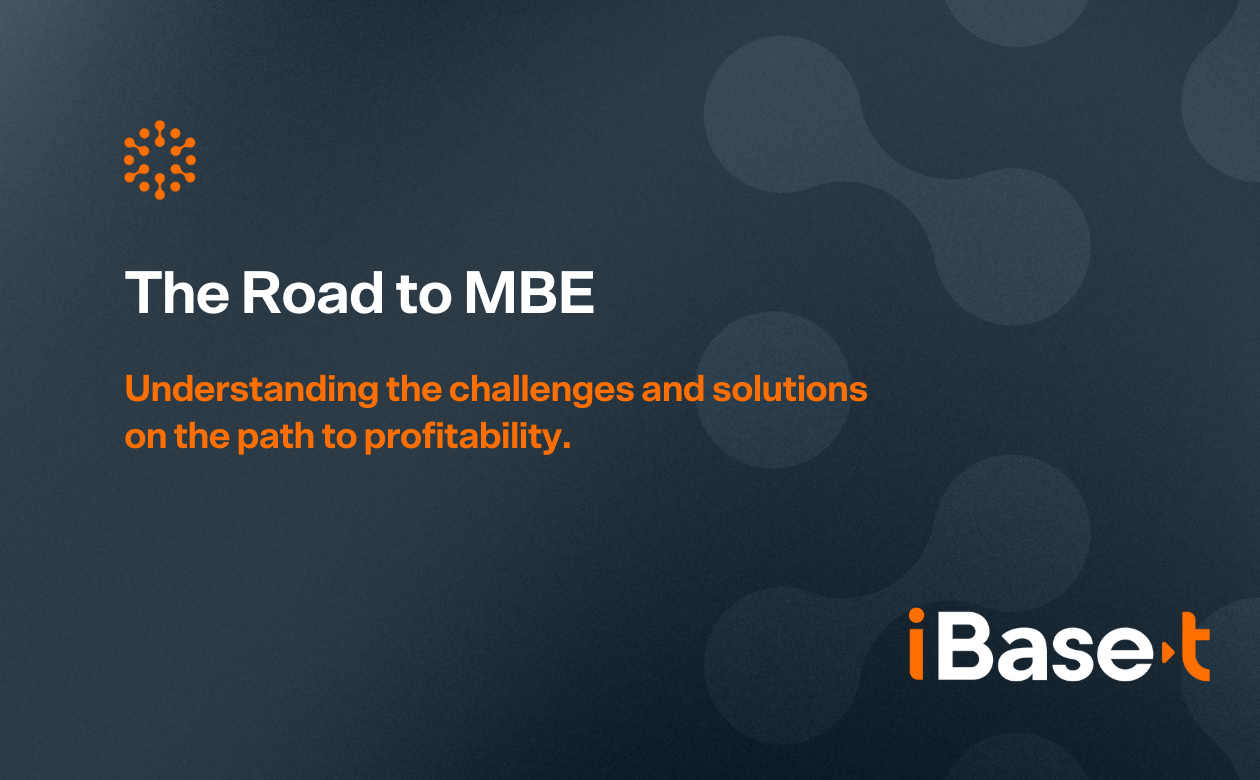The Solumina i120 release introduces groundbreaking innovations to accelerate model-based digital transformation, improve operational agility, and deliver a more intuitive and configurable user experience. Read on to learn more!
Key Enhancements of Solumina i120 Include:
Model-based MES:
MBE Pro (requires an additional license) delivers Solumina’s most powerful model-based MES capabilities to date – including work instructions enriched with 3D model PMI, interactive highlighting in shop floor execution, and much more:
- Integration of PLM Bill of Characteristics: In MBE Pro, a model-based PLM Bill of Characteristics (BoC) for a part/revision can be brought into Solumina to create an Inspection Definition. This allows the Inspection Definition items to be embedded into the Process Plan work instructions as a Parametric Data Collection during process planning. This integration creates a digital thread that links model-based characteristics directly to your work instructions, improving accuracy and precision on the shop floor and driving a single source of truth across your enterprise.
- Assign PMI Data to Parametric Data Collections: Once the Inspection Definition Items have been embedded into the Process Plan work instructions as a Parametric Data Collection (PDC), process planners can assign 3D model Production Manufacturing Information (PMI) to the PDCs in the work instructions.

- Save CAD Views: When assigning a 3D model object to a data collection, process planners can also save a view to focus on a specific part of an assembly or PMI, enabling shop floor technicians to instantly pan or zoom into the relevant area on the 3D model. This provides clarity and drives efficiency during data collection.

- Interactive “Tri-lighting” in Shop Floor Execution: Linking the 3D model PMI to the Parametric Data Collection in the work instructions enables three-way highlighting – or “tri-lighting” – that connects the model, data collection, and work instructions within the Shop Floor Execution Web UI. When any of the three objects is clicked, the other two corresponding objects are highlighted. The highlighting on the model includes any panned, zoomed, or rotational settings saved as CAD Views by the process planner. This interactive visual experience helps technicians easily identify and measure dimensions on the shop floor, improving quality and efficiency.

- Discrepancy Highlighting: With MBE Pro, the 3D model can visually indicate discrepancies, alerting users to issues. If a technician installs a part with a discrepancy in it into an assembly, the part will be highlighted in red on the 3D model. Additionally, when a discrepancy is created for a data collection out-of-tolerance condition, the dimension associated with that data collection will appear in red on the model. Parts and dimensions remain red until the discrepancy is resolved, ensuring visibility and accountability across teams.

- MBE Data Added to Supersede Process – When an engineering or manufacturing change arises, the process plan can be updated, applying the changes to the 3D model and superseding the instructions to open orders on the shop floor.
Introducing the Web UI Configurator:
The Solumina Web UI Configurator is a new, built-in tool that empowers customers to tailor Solumina’s web interface to their organization’s unique needs – without modifying the system’s backend business logic. It provides flexibility to reconfigure and extend Solumina’s out-of-the-box data presentation, delivering the ease and efficiency of a bespoke user experience without the risk of upgrade or portability challenges.
In i120, the Web UI Configurator can be used to configure Solumina’s Dispatches and Work Order screens, with additional areas of the solution coming soon.

- Redesigned, Configurable Dispatches: Dispatches have been rewritten in a new, configurable framework, allowing users to customize their views and interactions with data. Using the new Web UI Configurator, you can now add and remove fields, change presets, add buttons and more. You can even create your own dispatches to view the data you want to see. Dispatches have also been updated with tabs to provide a more information-rich view with convenient access to additional context.

Process Planning & Shop Floor Execution:
- Redesigned, Configurable Work Order Experience: Solumina’s Work Order screens have been rewritten in our new configurable architecture, allowing for the use of the Web UI Configurator. The design of the Work Order screens has also been refreshed for a more streamlined experience, with enhancements including:
- A new user-agnostic design that supports a wider range of roles. Now, technicians and inspectors, supervisors, engineers, and more can execute transactions within the same screens, driving efficiency and improving collaboration.
- A streamlined display of the Work Instructions and 3D model, featuring modular screen components that can be adjusted and resized as desired for an improved user experience.
- An updated “Need to Collect” panel that replaces the previous form-style layout with a more structured, grid-style layout for easier data collection.


- Barcode Scanning with Handheld Devices: Technicians performing data collections in the Web UI can now use the camera settings of a handheld device, such as an iPad, to scan 1D and 2D barcodes, driving efficiency.
- Authority Document for Task Groups in MRO Plans: An MRO manual or other regulatory document can now be tied to the Task Groups to which it applies, enabling traceability to demonstrate that the authoritative document has been followed.
EQMS and SQM:
- Geometric Dimensioning & Tolerancing (GD&T) Requirements: GD&T information can now be added to Inspection Items and Data Collections. Engineers can include GD&T when authoring requirements in the Process Plan or Inspection Definition in the Windows Client. These requirements are then visible to technicians on the shop floor via the Web UI.
- New Fields for Data Collections: The following attributes have been added to Data Collections to support better alignment with Inspection Items, where these fields were already present.
- Inspection Method: A new optional field for Inspection Method, with user-defined drop-down options, allows engineers to specify how a feature should be inspected for a particular Data Collection (e.g., visual inspection, a gauge, x-ray, non-destructive testing, etc.).
- Reference Number: A new reference number field has been added to Data Collections. A reference number might be used to denote specific measurements (like weight, color, or dimensions) or quality standards (like tolerance levels or material types). This supports traceability and standardization of data collections.

- Author Disposition Instructions in Any Work Order – Users can now author disposition instructions in any open work order they see fit, regardless of the item number. This means that when an issue is found on a work order for a component part, the user can author the disposition instructions in a separate work order for the higher-level assembly.
Architecture & Security:
- Stability & Security Enhancements: The Solumina software stack has been enhanced for improved stability for backups and upgrades. Security improvements have also been introduced to allow for easier, more secure access to supporting services.
These are just a few of the enhancements delivered in Solumina i120! To learn about all the new capabilities in the i120 release, please see the Solumina i120 Release Bulletin in the iSeries Install Instructions and Collateral Release page > Solumina i120 section within the iBase-t Knowledge Center.
Ready to try out the new release? To get Solumina i120, please submit a ticket to iBase-t Customer Support.




